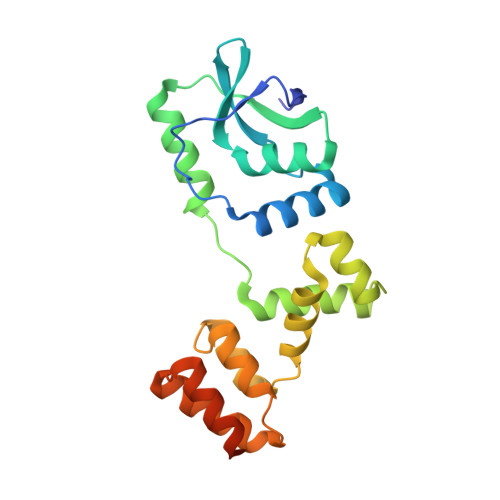The CTPase activity of ParB determines the size and dynamics of prokaryotic DNA partition complexes.
Osorio-Valeriano, M., Altegoer, F., Das, C.K., Steinchen, W., Panis, G., Connolley, L., Giacomelli, G., Feddersen, H., Corrales-Guerrero, L., Giammarinaro, P.I., Hanssmann, J., Bramkamp, M., Viollier, P.H., Murray, S., Schafer, L.V., Bange, G., Thanbichler, M.(2021) Mol Cell 81: 3992
- PubMed: 34562373
- DOI: https://doi.org/10.1016/j.molcel.2021.09.004
- Primary Citation of Related Structures:
7BNK, 7BNR, 7O0N - PubMed Abstract:
ParB-like CTPases mediate the segregation of bacterial chromosomes and low-copy number plasmids. They act as DNA-sliding clamps that are loaded at parS motifs in the centromere of target DNA molecules and spread laterally to form large nucleoprotein complexes serving as docking points for the DNA segregation machinery. Here, we solve crystal structures of ParB in the pre- and post-hydrolysis state and illuminate the catalytic mechanism of nucleotide hydrolysis. Moreover, we identify conformational changes that underlie the CTP- and parS-dependent closure of ParB clamps. The study of CTPase-deficient ParB variants reveals that CTP hydrolysis serves to limit the sliding time of ParB clamps and thus drives the establishment of a well-defined ParB diffusion gradient across the centromere whose dynamics are critical for DNA segregation. These findings clarify the role of the ParB CTPase cycle in partition complex assembly and function and thus advance our understanding of this prototypic CTP-dependent molecular switch.
- Department of Biology, University of Marburg, 35043 Marburg, Germany; Max Planck Institute for Terrestrial Microbiology, 35043 Marburg, Germany.
Organizational Affiliation:





















